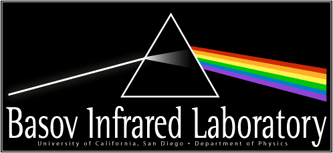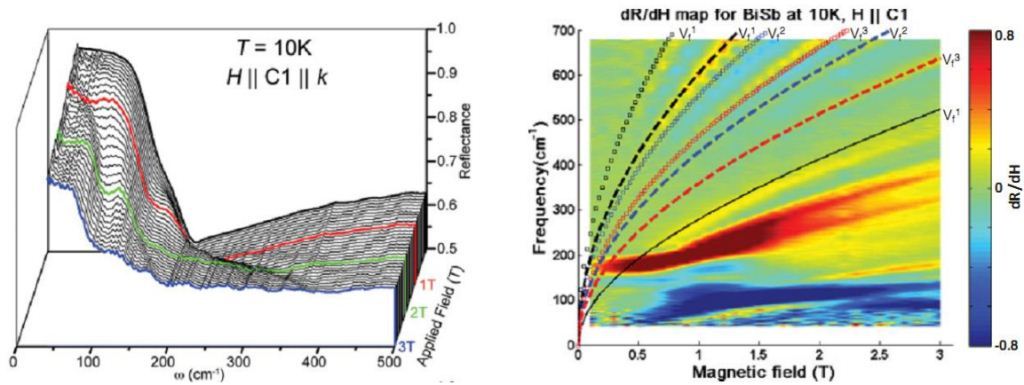| Infrared Nano-Optics of Quantum Materials | |||
|---|---|---|---|
Topological InsulatorsRecently, several compounds have vaulted into the forefront of the condensed matter field after being named prime candidates for the physical realization of a new class of materials, known as topological insulators. A topological insulator has an energy gap in the bulk, however, unlike traditional insulators or semiconductors, topological insulators are topologically inequivalent to the vacuum. A fundamental consequence and principle experimental indicator of the non-trivial topology is one or more robust metallic surface states that are protected both from localization and backscattering by time-reversal symmetry. Beyond the inherent importance of exploring a complex phase of quantum matter, these systems are of great interest for device applications such as quantum computing and photonics.
Figure 1. [From: LaForge et al., Phys. Rev. B 81, 125120 (2010)] Panel a shows representative far-infrared reflectance data from a series of temperature and magnetic field dependent measurements of the topological insulator Bi2Se3. Panel B highlights the behavior of the α phonon in the presence of a magnetic field directed along the c axis of the crystal. This phonon becomes increasingly asymmetric as the magnetic field increase, exhibiting a Fano lineshape. The asymmetry is quantified by the parameter q, which as shown in panel c, scales with the free carrier scattering rate. This latter fact is indicative of an interaction of the phonon with the continuum free-carrier spectrum and significant magneto-electric coupling.
Infrared magneto-optical studies of Topological insulators The energy scales accessible by the instruments in our lab (sub-THz to UV light) allow us to explore a multitude of electronic processes vital to understanding the physics of these materials. These processes include the electromagnetic response of both bulk and surface state charge carriers, the electronic structure at the edge of the bulk energy gap, as well as optical excitations of higher energy due to the complex band structure beyond regions near the local band minima/maxima of the bulk gap. Moreover, our instrumentation allows experiments covering these energy ranges to be performed in high magnetic fields. In the presence of a magnetic field, topological insulators exhibit exotic effects, including gapping of the surface states into quantized Landau levels, which can be observed at energy scales readily accessible in our lab.
Figure 2. [From: Schafgans et al., Phys. Rev. B 85, 195440 (2012)] The left panel shows the magnetic field dependence of the far-infrared reflectance spectra of the topological insulator Bi0.91Sb0.09. By plotting this data in terms of the differential reflectance dR/dH, shown in the right panel, distinct modes become apparent. The frequencies of these modes are at an energy scale consistent with Landau level transitions. Moreover, these modes exhibit a dispersion that scales with the square root of the magnetic field, rather than linearly as expected in a bulk material. The observed dispersion is accord with predicted transitions between surface state Landau levels.
Magnetic TIs Many of the exotic properties of topological insulators rely upon the time-reversal symmetric nature of their band structure. The onset of spontaneous magnetization due to exchange coupled magnetic dopants introduces long range order, which breaks the time reversal symmetry and gaps the surface state. Current and future research in our group is focused topological insulators (e.g. Bi2Se3, Bi2Te3) doped with select transition metals (Mn or Cr). Such materials form a new class of dilute magnetic semiconductors: the dilute magnetic topological semiconductor. The initial investigations will examine the electronic structure and dynamics in the ferromagnetic state, and across the transition into the paramagnetic state, as well as the nature of the exchange interaction in these materials.
Recent Publications: [1] Schafgans et al., Phys. Rev. B 85, 195440 (2012) [2] LaForge et al., Phys. Rev. B 81, 125120 (2010) |
|||
t |
|||
 |
|||

